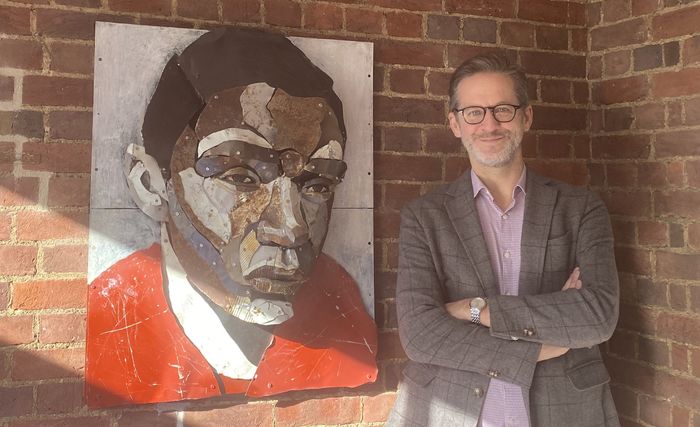‘The Robin Hood of the art world?’: Max Brandrett and the ethics of art forgery
Infamous art forger Max Brandrett speaks at the union about forgery, painting, and a run-in with the Kray twins

Sliding into the second leather pew of the Cambridge Union Debate Chamber, I waited for “Britain’s Most Famous Art Forger”, advertised as an “eccentric artist and gentleman” with a “colourful lifestyle”. But nothing could have prepared me for the vivid vignette of a life of circuses, auction houses, prison stints and philanthropy rendered (with rather colourful language) by the eccentric old man who walked in.
From Caravaggios and Coolidges to Turners and Vermeers, Max Brandrett says “he’s faked everybody”, spending 15 years flogging counterfeits of anything from caricatures to classical canvases. Spilling trade secrets, he delightedly divulged how – with only a hairdryer, beard glue, rusty nails and a hoover bag’s contents – he transformed shipping scenes slapped onto beaten-up canvases into 17th-century “antiques”. Strolling up to sellers as an art-illiterate father-son duo and feigning surprise at the priceless collector’s items among their “rubbishy paintings”, he and his mentor racked up their rates at auction until some poor soul parted with thousands of pounds for something whipped up over the weekend.
“Brandrett has paid back the stolen profits from the elite art world to those also barred from its benefits”
Brandrett gained this “gift of the gab” from surviving a childhood in care; by weaselling his way out the clutches of bullies in Barnardo’s, he gained the street-smarts that paved the way for a career of duping dealers. Later, busking with two songs and a few sketches for sale on Portobello road after running away from his job painting circus caravans landed him in the hands of the Kray Twins. Although he dodged the infamous gangsters’ invite to tea on Sunday after commissioning a “smudge” of their mum (claiming he would be at church) the criminal life caught up with Brandrett, who spent three prison stints repenting for his sins. Even bars didn’t stop him smuggling out pen and ink prints, which he hid in his Bible - while declaring during cell checks that he was “going by the book now”.
Despite painting himself as merely a “craftsman who lost his way”, Brandrett was first sentenced for robbing a guest-house while following “the hippie trail” to Cornwall. However amusing his antics, a disconcerting reality of deceit and exploitation underscores his shamelessly swindling of anyone just for the “thrill”, which he proudly declares he would do “all over again”.
However, although the scrutiny of multispectral imaging has cut short the days of pulling the wool over auctioneers’ eyes and leaving with stuffed pockets, Brandrett still lives for the buzz of painting. Welling up with emotion at the sight of a blank canvas and the anticipation of bringing to life standout touches in “The Taking of Christ”, he wakes up at night with “withdrawal symptoms”, itching for a brush and a Caravaggio to copy.
“He wakes up at night with ‘withdrawal symptoms’, itching for a brush and a Caravaggio to copy”
Raised in a cramped basement flat in Brighton, sharing shoes with his siblings and taking turns going to school, the privilege of a traditional art education was never in the cards. Forced to flee his mum’s abusive boyfriend and screw electric meters for a meal, he swindled simply to survive, so without the luxury of creative freedom, questions of authenticity and morality seem irrelevant – especially in light of the success of someone for whom gallery halls were unreachable without hiding behind signatures that sell.
Despite stressing that he doesn’t regret “a thing”, by raising thousands for Variety Club, auctioning his works in a Barnardo’s shop and holding art classes in nursing homes, Brandrett has paid back the stolen profits from the elite art world to those also barred from its benefits.
Whether or not you endorse this reformed Robin Hood, he’s undoubtedly become a criminal superstar. Proudly recommending his own book and film – biography “Britain’s No1 Art Forger – The Life of a Cheeky Faker” and forthcoming documentary “Chasing Caravaggio” – even he can’t seem to believe his luck. Going from being “dirt poor” to a popular novelty overnight after becoming the first person permanently banned from eBay for selling cheap ceramic ducks as collectables, Brandrett is far from being “out for a duck”; this ironically made his work a collectable itself, and he even offered “anybody wanna buy a duck? I did it, it’s original.”
Racking up millions of views in Vice and LadBible interviews and selling out at Mensa, he’s clearly traded the buzz of the criminal life for the thrill of entertaining crowds. Telling his stories for free in the Cambridge Union on a Friday evening, he admitted: “I would do this for nothing – well, I am doing it for nothing.”
Finally able to make a living from his own name, Brandrett sat down to sign copies of his own biography after confessing to one last crime: using Scottish artist Jack Vettriano’s book signing to steal his autograph. Both immoral and inspirational, selling his own sensational story means the world can finally see – and judge for themselves – the authentic truth of the talent and tricks of “Max the Forger”.
 Comment / The case for handwritten exams10 January 2025
Comment / The case for handwritten exams10 January 2025 News / Competitive tiddlywink trio return to celebrate 70th anniversary 13 January 2025
News / Competitive tiddlywink trio return to celebrate 70th anniversary 13 January 2025 Features / An investigation into women and sex at Cambridge7 January 2025
Features / An investigation into women and sex at Cambridge7 January 2025 Sport / Netball for net-all: it’s time to take mixed netball seriously13 January 2025
Sport / Netball for net-all: it’s time to take mixed netball seriously13 January 2025 Comment / Cambridge’s outreach departments deserve some love14 January 2025
Comment / Cambridge’s outreach departments deserve some love14 January 2025






